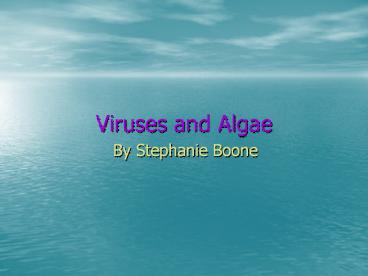Viruses and Algae - PowerPoint PPT Presentation
Title:
Viruses and Algae
Description:
Common characteristics Found on five continents tropical, ... Chlorella algae are small, spherical, unicellular, nonmotile, asexual reproducing green algae. – PowerPoint PPT presentation
Number of Views:118
Avg rating:3.0/5.0
Title: Viruses and Algae
1
Viruses and Algae
- By Stephanie Boone
2
Virus Facts
- Most abundant life form in aquatic systems.
- In the ocean the total number exceeds 1029.
- Marine viruses high concentrations up to 10 8 in
ml-1 - Play a significant role in the transfer of matter
and energy in aquatic microbial food webs. - Infect at least some members of all the major
classes of freshwater and marine algae. - Reported in at least 44 taxa of eukaryotic algae
- Includes members 10 of 14 classes of algae
- Virus Interactions range from
- true parasitism (chronic infection/cellular
release without death) - to predation (lytic infection resulting in cell
death).
3
Ecological Significance
- Play a significant role in the transfer of matter
and energy in aquatic microbial food webs. - Viral lysis of algae effects carbon nutrient
flow. - Carbon stored in dissolved organic matter
released into system. - May influence carbon cycling and climate.
- Significant role in transfer of information
through DNA. - Important role in algae blooms.
- effect marine community structure.
4
Algal Viruses
- Despite the established ecological importance of
marine viruses there have been few studies which
extensively investigate and characterize viruses
of algae. - The viruses studied extensively fall into two
catagories.
- Large ds DNA viruses.
- PBCV-1, Fsv, EsV
- Small viruses.
- HaRNA, HaNIV
5
Large dsDNA Viruses
- Family Phycodnaviridae
- Paramecium bursaria chorella virus (PBCV-1)
infect eukaryotic unicellular-like green algae. - Ectocarpus virus (EsV) Feldmannnia virus (FsV)
infect marine brown alga. - Common characteristics
- Found on five continents
- tropical, subtropical seawater, and freshwater
- large icosahedral particles 130-190 nm diameter
- large dsDNA genomes 160-380 kb
- Viral capsid assembly and DNA packaging occurs in
the cytoplasm
6
PBVC-1/ Chlorella virus
- PBVC-1 infects chlorella algae strain NC64A or
Pbi. - Chlorella algae are small, spherical,
unicellular, nonmotile, asexual reproducing green
algae. - Hereditary endosymbionts in protozoan P.
bursaria - resistant to viral infection when in
symbiotic relationship. - PBCV-1 - linear nonintegrated genome
- 16 classes of virus
- Virus attaches to agal cell wall with hexagonal
vertices, digests the wall releases viral DNA
into cell. - Packaging and assembly of virions takes place in
cytoplasm virus released by localized cell wall
lysis
7
EsV FsV- Brown algal viruses
- Ectocarpus virus (EsV) and Feldmannia virus (FsV)
infect brown algae - densely packed polyhedral viral particles
- do not infect vegetative cells
- viral particles displace normal reproductive
cells producing sterility - Viral capsid assembly and DNA packaging occur in
the cytoplasm after nuclear membrane
degeneration.
8
Small Viruses
- Heterosigma akashiwo nuclear inclusion virus
(HaNIV) and Heterosigma akashiwo RNA virus
(HaRNAV) infect the algae Heterosigma akashiwo
(Raphidophyceae) a toxic bloom-forming microalgae - Host specific - simultaneous coinfection.
- HaRNAV 25 nm diameter
- polyhedral symmetry
- HaNIV 30 nm diameter
- replicates to high copy number (105) before host
lysis - nonenveloped and hexagonal implying icosahedral
symmetry. - Each virus forms a crystalline array
- Arrays located in different parts of cell.
9
- Conclusion
- Need more research.
- We know very very little about the viruses that
infect algae.
- References
- Van Etten J L, Meints R H. Giant viruses
infecting algae. Annual Review of Microbiology
199953447-494. - Weinbauer M G, Rassoulzadegan F. Are viruses
driving microbial diversification and diversity.
Envirnmental Microbiology 2004 6 1-11. - Lawrence J E. Chan A M. A novel virus (HaNIV)
causes lysis of the toxic bloom-forming alga
Heterosigma akashiwo (Raphidophyceae). Journal of
Phycology 2001 37216-222. - Tai V, Lawerence J E, Lang A S, Chan A M, Culley
A I, Suttle C A. Characetrization of HaRNAV, a
single stranded RNA virus causing lysis of
Heterosigma akashiwo (Raphidophyceae). Journal of
Phycology 2003 39 343-352.































